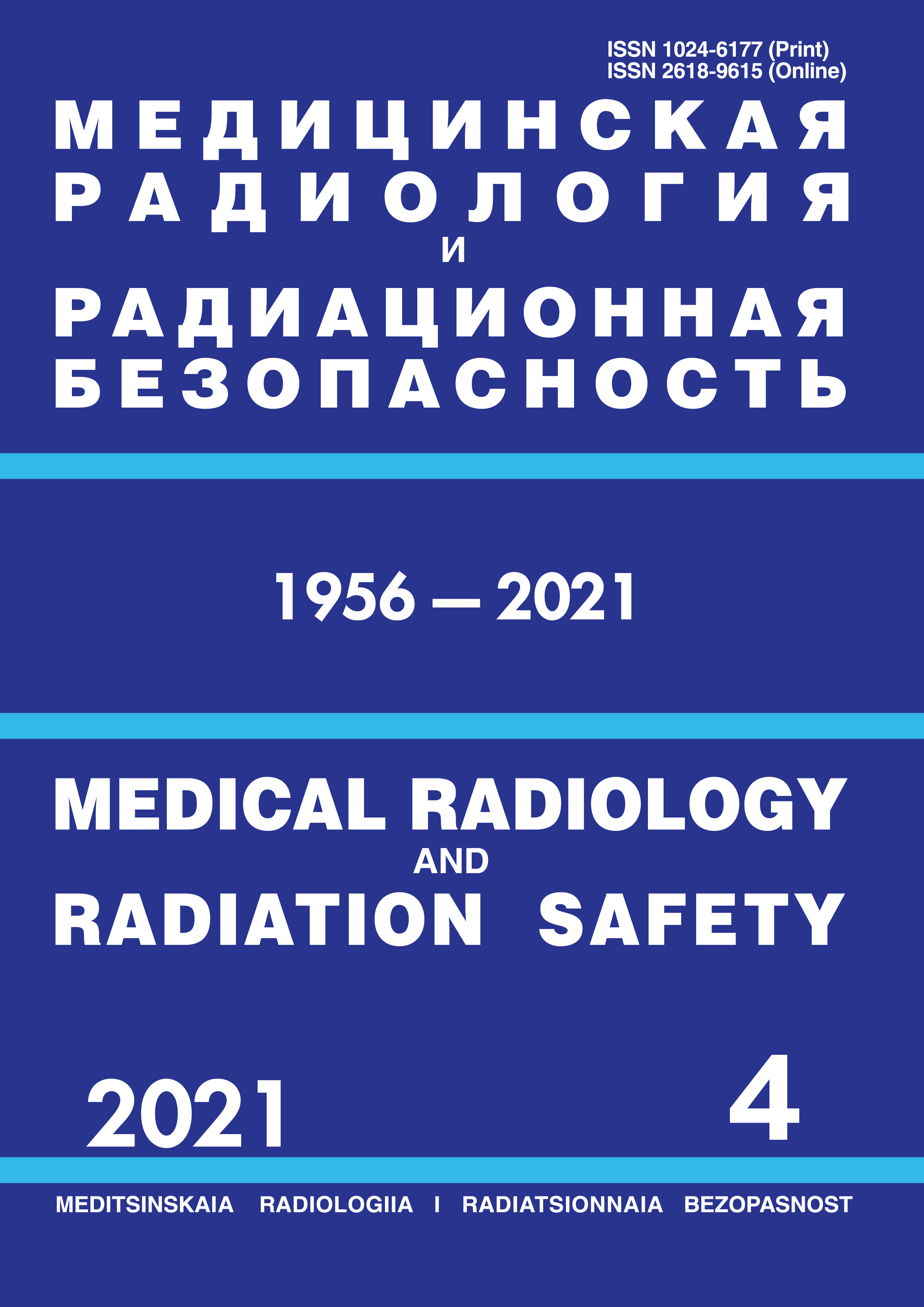Russian Federation
Russian Federation
Moscow, Russian Federation
Russian Federation
Russian Federation
Moscow, Russian Federation
Moscow, Russian Federation
Moscow, Russian Federation
CSCSTI 76.33
CSCSTI 76.03
Russian Classification of Professions by Education 31.06.2001
Russian Classification of Professions by Education 31.08.08
Russian Classification of Professions by Education 32.08.12
Russian Classification of Professions by Education 14.04.02
Russian Library and Bibliographic Classification 534
Russian Library and Bibliographic Classification 51
Russian Trade and Bibliographic Classification 5712
Russian Trade and Bibliographic Classification 5734
Russian Trade and Bibliographic Classification 6212
Russian Trade and Bibliographic Classification 5708
Purpose: To analyze the features of the clinical course of chronic radiation syndrome (CRS) due to external non-uniform chronic exposure to prolonged household contact with a lost source of ionizing radiation. Material and methods: Analysis of 2 clinical observations of patients who developed subacutecourse of CRS and chronic radiation dermatitis due to external non-uniform exposure of the lost sources of ionizing radiation are presented. Results: Boy A. K. from the age of 1 year for 7 years was external radiation exposed (for 1.5 years non-uniform exposure ) to the total dose according EPR tooth enamel about 6.3 Gy, according to the data of retrospective dose recovery on red bone marrow using voxel modeling – 26 (19–37) Gy. F. V. V., male, 38 years, was external non-uniform radiation exposed for 5 months, the total dose according cytogenetic studies of 7.9 Gy (dose rate about 0.035 Gy/h). During the examination in the hospital, the patients were diagnosed with CRS. Within the framework of the bone marrow syndrome, deep thrombocytopenia, moderate leuko- and neutropenia, and moderate anemic syndrome were observed. The latter is not typical for the typical course of CRS and is a criterion indicating a subacute course of the disease. In addition, signs of chronic radiation dermatitis were found in the projection of the action of the ionizing radiation beam. After stopping the radiation exposure, the patients did not recover their hematopoietic function, and in the period of immediate consequences, they developed myelodysplastic syndrome (MDS) with further transformation into acute leukemia. Conclusion: 1. Accidental prolonged household or criminal contact with a source of ionizing radiation can lead to the formation of CRS with an atypical subacute course and the formation of MDS with transformation to acute leukemia in the outcome of the disease or in the period of its consequences. 2. It can be assumed that with external non-uniform radiation exposure, leading to the development of CRS and chronic radiation damage to the skin, agranulocytosis in the subacute course of CRS may be absent. 3. Adverse prognostic signs for the development of MDS and leukemia in the outcome or in the period of the consequences of subacute CRS with non-uniform exposure are long-lasting deep thrombocytopenia and anemic syndrome after the end of radiation exposure.
chronic radiation syndrome, subacute course, non-uniform radiation exposure, lost radiation source, agranulocytosis, anemic syndrome, myelodysplastic syndrome, acute leukemia
1. Galstyan I.A., Metlyaeva M.A., Konchalovskiy M.V., Nugis V.Yu., Scherbatyh O.V., Yunanova L.A. i dr. «Podostroe» techenie hronicheskoy luchevoy bolezni. Medicinskaya radiologiya i radiacionnaya bezopasnost'. Prinyata v pechat'.
2. Krasnyuk V.I., Konchalovskiy M.V., Ustyugova A.A. Klinicheskie osobennosti podostrogo techeniya luchevoy bolezni. Saratovskiy nauchno-medicinskiy zhurnal. 2014. T.10. №4. S. 858-862.
3. Hwang S-L, Guo H-R, Hsieh W-A, Hwang J-S, Lee S-D, Tang J-L, et al. Cancer risks in a population with prolonged low dose-rate gamma-radiation exposure in radiocontaminated buildings, 1983-2002. Int J Radiat Biol. 2006;82(12):849-58. DOI:https://doi.org/10.1080/09553000601085980.
4. ICRP Pubication. 110. Adult Reference Computational Phantoms. SAGE Publications Ltd. May 2010: 166. |
5. Agostinelli S. et al. Geant4 - A Simulation Toolkit, Nucl. Instrum. Meth. A 2003;506:250-303.
6. Allison J. et al. Geant4 - Developments and Applications, IEEE Trans. Nucl. Sci. 2006;53:270-278.
7. Agostinelli S. et al. Geant4 - A Simulation Toolkit, Nucl. Instrum. Meth. A 2003;506:250-303.
8. Sevan'kaev A.V., Hvostunov I.K., Snigireva G.P., Novickaya N.N., Antoschina M.M., Fesenko E.V. i dr. Sravnitel'nyy analiz rezul'tatov citogeneticheskih obsledovaniy kontrol'nyh grupp lic v razlichnyh otechestvennyh laboratoriyah // Radiacionnaya biologiya. Radioekologiya. 2013. T. 53. № 1. C.5-24.
9. Cytogenetic dosimetry: Applications in preparedness for and response to radiation emergencies. Vienna: IAEA, 2011. 229 p.
10. Snigireva G.P., Bogomazova A.N., Novickaya N.N., Hazins E.D., Rubanovich A.V. Biologicheskaya indikaciya radiacionnogo vozdeystviya na organizm cheloveka s ispol'zovaniem citogeneticheskih metodov. Medicinskaya tehnologiya №FS-2007/015-U. M., 2007. 29 s.
11. Nugis V.Yu., Dudochkina N.E. Zakonomernosti eliminacii aberraciy hromosom u lyudey posle ostrogo oblucheniya po dannym kul'tivirovaniya limfocitov perifericheskoy krovi v otdalennye sroki // Radiacionnaya biologiya. Radioekologiya. 2006. T. 46. № 1. C.5-16.
12. Baranov AE, Guskova AK, Davtian AA, Sevan`kaev AV, Lloid DC, Edwards AA, et al. Protracted overexposure to a 137Cs source: II. Clinical sequelae. Radiation Protection Dosimetry. 1999. T. 81. № 2. C. 91-100.
13. Sevan`kaev AV, Lloid DC, Edwards AA, Mikhailova GF, Nugis VYu, Domracheva EV, et al. Protracted overexposure to a 137Cs source: I. Dose Reconstruction. Radiation Protection Dosimetry. 1999. T. 81. № 2 C.85-90.
14. Nugis V.Yu., Snigireva G.P., Lomonosova E.E., Kozlova M.G., Nikitina V.A. Trehcvetnyy FISH-metod: krivye doza-effekt dlya translokaciy v kul'turah limfocitov perifericheskoy krovi posle gamma-oblucheniya in vitro // Medicinskaya radiologiya i radiacionnaya bezopasnost'. 2020. T.65. №5. C.12-20.
15. Mielodisplasticheskiy sindrom. Klinicheskie rekomendacii. 2020. 94 s.
16. Selidovkin GD, Barabanova AV. Ostraya luchevaya bolezn' ot obschego oblucheniya. Radiacionnaya medicina pod red. L.A. Il'ina. IzdAT. 2001. T. 2. S. 62-89.





